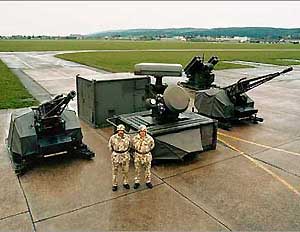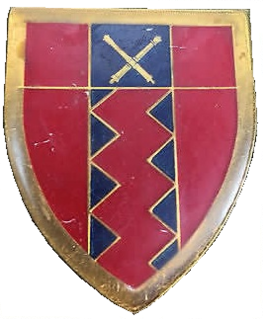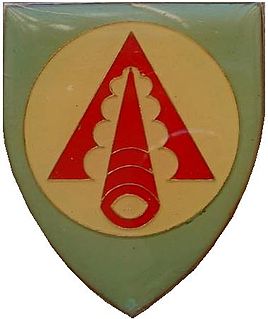
The Royal Regiment of Artillery, commonly referred to as the Royal Artillery (RA) and colloquially known as "The Gunners", is the artillery arm of the British Army. The Royal Regiment of Artillery comprises thirteen Regular Army regiments, King's Troop Royal Horse Artillery and five Army Reserve regiments.

Anti-aircraft warfare or counter-air defence is the battlespace response to aerial warfare, defined by NATO as "all measures designed to nullify or reduce the effectiveness of hostile air action". It includes surface based, subsurface, and air-based weapon systems, associated sensor systems, command and control arrangements, and passive measures. It may be used to protect naval, ground, and air forces in any location. However, for most countries the main effort has tended to be homeland defence. NATO refers to airborne air defence counter-air and naval air defence as anti-aircraft warfare. Missile defence is an extension of air defence, as are initiatives to adapt air defence to the task of intercepting any projectile in flight.

Starstreak is a British short range man-portable air-defence system (MANPADS) manufactured by Thales Air Defence, in Belfast. It is also known as Starstreak HVM. After launch, the missile accelerates to more than Mach 4, making it the fastest short-range surface-to-air missile in the world. It then launches three laser beam riding submunitions, increasing the likelihood of a successful hit on the target. Starstreak has been in service with the British Army since 1997. In 2012, Thales rebranded the system under the ForceSHIELD banner.

The Royal Regiment of Australian Artillery, normally referred to as the Royal Australian Artillery (RAA), is a Regiment of the Australian Army descended from the original colonial artillery units prior to Australia's federation. Australia's first guns were landed from HMS Sirius and a small earthen redoubt built, near the present-day Macquarie Place, to command the approaches to Sydney Cove. The deployment of these guns represents the origins of artillery in Australia. These and subsequent defences, as well as field guns, were operated by marines and the soldiers of infantry regiments stationed in Australia. Unlike their British and Canadian equivalents, there are no regiments of horse artillery in the order of battle of the Royal Australian Artillery. The First World War saw the raising of 60 field, 20 howitzer, and two siege batteries along with the heavy and medium trench mortar batteries. Until 19 September 1962 the Australian Artillery was referred to as the 'Royal Australian Artillery', however, on this date Queen Elizabeth II granted the RAA the title of 'The Royal Regiment of Australian Artillery'. The Regiment today consists of Regular and Reserve units.

The QF 3.7-inch AA was Britain's primary heavy anti-aircraft gun during World War II. It was roughly the equivalent of the German Flak 8.8 cm and American 90 mm, but with a slightly larger calibre of 3.7 inches, approximately 94 mm. Production began in 1937 and it was used throughout World War II in all theatres except the Eastern Front. It remained in use after the war until AA guns were replaced by guided missiles beginning in 1957.

The Oerlikon GDF or Oerlikon 35 mm twin cannon is a towed anti-aircraft gun made by Oerlikon Contraves. The system was originally designated as 2 ZLA/353 ML but this was later changed to GDF-001. It was developed in the late 1950s and is used by around 30 countries.

Skyshield Air-defence system is a modular, light weight, Short Range Air Defense (SHORAD) system developed by the Swiss corporation Oerlikon Contraves. The successor to the Skyguard defense system, Skyshield is intended to rapidly acquire and destroy threatening aircraft and missiles, as well as to fulfill a C-RAM role.

The South African Army Artillery Formation is the controlling entity of all South African Army artillery units. It draws much of its history from the South African Artillery, established in 1934 but with roots that reach back to 1921. The formation consists of both regular and reserve units. There is a separate South African Army Air Defence Artillery Formation that directs army anti-aircraft warfare units.

The Rejimen Artileri DiRaja is the artillery corps of the Malaysian Army. Rejimen Artileri DiRaja was formed in Kajang on 15 August 1957 when a single battery was formed, drawn from Malay personnel formerly serving with the British Army's Royal Regiment of Artillery. Today Rejimen Artileri DiRaja is a modern fighting arm providing direct fire support to Malaysian Army units using field artillery pieces and MLRS.

12 Regiment Royal Artillery is a regiment of the Royal Artillery in the British Army. It currently serves in the air defence role, and is equipped with the Starstreak missile.

The Regiment of Artillery is a Combat Firepower arm of the Indian Army, a successor to the Royal Indian Artillery (RIA) of British Indian Army, which itself traces its origins to the formation of Bombay Artillery in 1827.

The South African Army Air Defence Artillery Formation is the controlling entity of all South African Army Air Defence Artillery units. This Formation consists of both regular and reserve units.

The Sekhukhune Anti-Aircraft Regiment is an air defence regiment of the South African Army. It is part of the South African Army Air Defence Artillery Formation. It is located in Johannesburg.

The iWombe Anti-Aircraft Regiment is a reserve air defence regiment of the South African Army.

The Madzhakandila Anti-Aircraft Regiment is a air defence regiment of the South African Army.

Regiment Overvaal is a reserve force regiment of the South African Army Air Defence Artillery Formation.

132nd (Mixed) Heavy Anti-Aircraft Regiment was an air defence unit of Britain's Royal Artillery formed during World War II. It was one of the first 'Mixed' regiments in which women of the Auxiliary Territorial Service were integrated into the unit's personnel. It defended London and South-East England against aerial attack until it deployed to Belgium in January 1945 to defend Brussels against V-1 flying bombs.

228th (Edinburgh) Heavy Anti-Aircraft Battery, Royal Artillery was a Scottish air defence unit of Britain's Territorial Army (TA) formed in the City of Edinburgh during the period of international tension leading up to the outbreak of World War II. It defended Eastern Scotland during the early part of the war and then served in the defence of Gibraltar. Its successor unit served in the postwar TA as air defence artillery and as engineers until 1999.

15th Anti-Aircraft Brigade was an air defence formation of the Royal Artillery which saw service during the middle years of the Second World War. The brigade was formed in Gibraltar to control those anti-aircraft (AA) units based there and disbanded shortly after the air threat had been diminished in 1944. The brigade was later reformed in 1947 as part of the post-war regular army, but disbanded in 1957 following the end of the AA era.




















